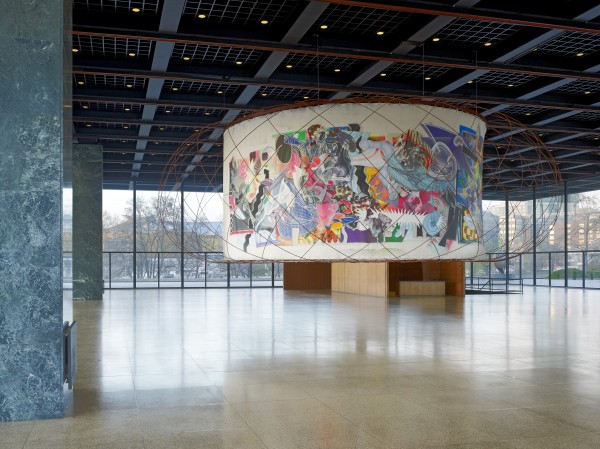Santiago Calatrava and Frank Stella
Tuesday, 23 August 2011
Santiago Calatrava and Frank Stella
Work from The Michael Kohlhaas Curtain @ The Neue Nationalgalerie with text by Nicholas O’Brien.
“Upon approaching the renown last building by Mies van der Rohe, a distinct glass pavilion supported by the German architect’s signature grid of steel beams, one immediately is captivated by the massive caged painting that hangs roughly seven feet from the floor. The structure, a collaboration between Santiago Calatrava and Frank Stella, is at once imposing and sublime. The neon colors of the 98 foot mural immediately jump out and clash against the surrounding stoic tones, while the gridded donut enclosure acts as an update the stagnant flat grid of Late Modern architecture. The collaboration between these two acclaimed figures manifests as an attempt to create a visual narrative within the space that traces a route from the Modern to the Contemporary. The Curtain certainly takes cues from early 20th century murals, but instead of opting for a figurative approach, this collaboration tells an abundantly abstract story of the reciprocating influence that painting and architecture have had upon one another, as well as point toward a vivid future where both disciplines can merge into one grand gesture.
Although Stella’s work appears flat from a distance, closer examination of the structure reveals a vibrating surface that contains multiple layers and shapes that could be mistaken for onomatopoeia bubbles found in comic books or default software paint brushes – a gesture that speaks as much to PaintFX as it does to the legacy of Roy Liechtenstein. Amidst all of the organic forms, and their inorganic color schemes, glimpses of a comment on the bravado of architecture peak out intermittently. Warped gridded lines move along the mural in strokes that begin to resemble columns. The shapes that undulate beneath the top surface reference mechanical floor plan drawings, or else borrow from a palette familiar to anyone who has worked with a CAD process. But as quickly as these nods appear to the viewer, they recede just as rapidly behind gradients pulled from the look of an 80s air-brushed billboard.
As one walks around Calatrava’s encasing web, one begins to see how his contribution acts as a counter swing in the pendulum that is this monumental work. The visual simplicity – but technical complexity – of the apparatus that holds together Stella’s mural exemplifies the desire that Yoshio Taniguchi stipulates for contemporary architecture to not just envelope, but to eventually “disappear.” The criss-crossing array certainly adds a sculptural component to the Curtain, but it also serves a purpose akin to the bridges that gave Calatrava his name. The frame in this collaboration creates a similar surface/space in which to transport and traffic mobility, but instead of cars being the primary vehicle of movement, Calatrava instead directs our eyes. The uniformity of his ornamentation creates a even distribution of attention along the chaotic scramble of Stella’s scribbles and loops.
The impact of the Curtain is undeniable, given its presence in the space, its resonating colors, its complex construction and installation, its ambition, and its balance between the baroque and the minimal. The collaboration between Calatrava and Stella is perhaps most successful due to the surprising reflexivity that emerges from the work as one navigates its density and observes the elegant meditative spaces resting between surface and structure.” – Nicholas O’Brien



